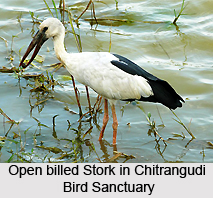 Chitrangudi Bird Sanctuary also known as Chitrangudi Kanmoli is located in Tamil Nadu. It is spread over an area of .4763 sq km. It was declared as a protected area in the year 1989 and is a part of Chitrangudi village in Mudukulathur Taluk in Ramanathapuram District. The forest serves as a habitat to various migratory birds. The sanctuary is located adjacent to Kanjirankulam Bird Sanctuary.
Chitrangudi Bird Sanctuary also known as Chitrangudi Kanmoli is located in Tamil Nadu. It is spread over an area of .4763 sq km. It was declared as a protected area in the year 1989 and is a part of Chitrangudi village in Mudukulathur Taluk in Ramanathapuram District. The forest serves as a habitat to various migratory birds. The sanctuary is located adjacent to Kanjirankulam Bird Sanctuary.
Geography of Chitrangudi Bird Sanctuary
Chitrangudi Bird Sanctuary is located inside 15 m high embankments of the community irrigation tank. The embankment is almost 4.010 km. There are five sluices from which water is diverted to the agricultural lands. The wetland is unequal in depth. During normal rainfall it can hold water for 3 to 5 months. If excess water gets accumulated it is then diverted towards Chitrangudi village through a sluice gate. The sanctuary receives 715.2 mm waterfall throughout the year.
Flora and Fauna of Chitrangudi Bird Sanctuary
Chitrangudi Bird Sanctuary is rich in flora and fauna. The vegetation here is mostly Tropical Dry Deciduous forest. The most remarkable feature of the sanctuary is the prominent growth of Babul trees. Apart from this there are other tress like Prosopis juliflora, Bermuda grass and Dichanthium foveolatum. The first Babul plantation was done by Farm forestry division in the year 1979. Tamarind trees, Silk trees, Fig trees, Portia trees, Neem trees, Palmyra palms and Drumstick trees can be seen within the irrigation tank bund and the area outside the tank. The sanctuary is also rich in medicinal plants like Ocimum sanctum and Gloriosa superba.
Chitrangudi Bird Sanctuary is an ideal habitat for winter migratory birds. Various species of Heron and colonial birds can be seen here. The sanctuary provides extensive diversity in nesting. Other than these there are many other birds found here like Spot billed Pelican, Liitle egret, Grey hreon, Large egret, Open billed stork, Purple heron, Pond heron. Tourists and nature lovers mostly visit the sanctuary during the months from October to February. Tourists visiting the sanctuary can put up at PWD Rest House at Mudukulathur, Forest Rest House at Sayalgudi and at Paramakudi.
Chitrangudi Bird Sanctuary is well connected with all modes of transports. It is 120 kms from Madurai, 45 kms from Ramanathapuram and 12 kms from Sayakudi town. The nearest railway station is located at Ramanathapuram that is 45 kms away. The nearest Airport is at Madurai that is at a distance of 130 kms.



















